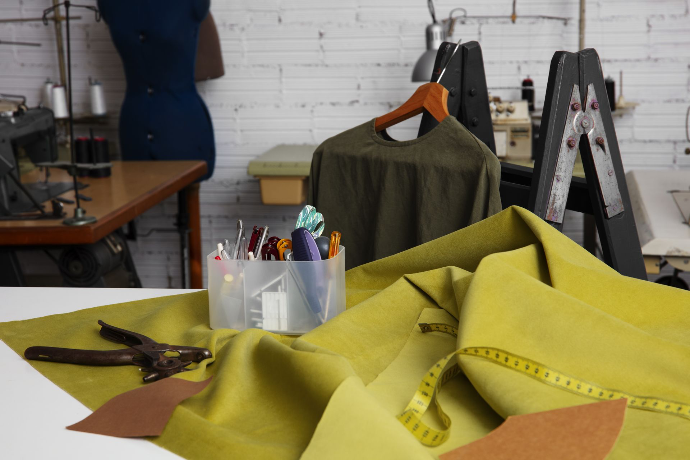Designing a fabric collection begins with gathering swatches and ends with a curated set of textiles tailored to a season or capsule line. In India’s textile industry, designers and buyers source swatches from multiple channels: directly from fabric mills and suppliers, from wholesale markets in textile hubs (e.g. Surat, Jaipur, Mumbai), or by attending industry trade fairs and exhibitions. Major sourcing centers include Gujarat (Surat and Ahmedabad) – known for cotton, denim and especially cost-effective polyester/synthetic knits – Maharashtra (Mumbai/Bhiwandi) for satin, georgette and processed fabrics, and Rajasthan (Jaipur/Jodhpur) for vibrant block-prints and tie-dyed. Designers often request swatch books or loose samples from textile manufacturers or fabric houses, and will pick up new samples at fairs or showrooms. As one sourcing guide notes, it is common to obtain swatches “from the fabric supplier or from the fabric maker,” and even via trade shows where “they physically feel garments before purchase.” These swatches form the raw palette from which a collection is built.
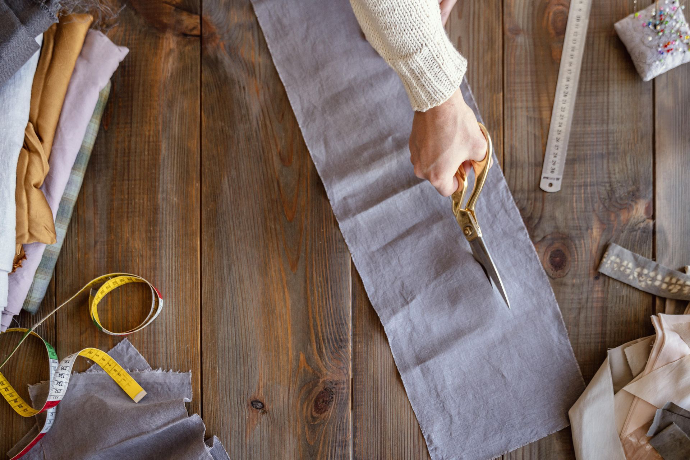
Evaluating Swatches: Texture, Drape and Feel
Once collected, swatches are tested and compared on key properties. Designers handle each sample to judge its hand-feel, texture and weight. Fabric weight (typically measured in GSM) is crucial: lightweight textiles like chiffons or organzas (20–50 gsm) drape softly, while mid-to-heavy fabrics like denim or wool (200+ gsm) hold a structured silhouette. Swatches let the team feel stretch and resilience, examine the tightness of the weave or knit, and see how the cloth moves. As one guide explains, swatches help assess “the drape, weight, and breathability of different fabrics” so designers can envision “the perfect fit and feel” for their garment. For example, a silk swatch’s luxurious sheen and soft hand immediately suggest how a dress would flow; the designer can physically drape the sample to see if it matches the vision. Color accuracy and consistency are checked under natural light (since dyes can look different indoors), and patterns or prints are evaluated for scale. In practice, designers often lay out swatches side by side (as in the image below) to compare hues and textures:
Fig: Colorful fabric swatches (strips of different fabrics) allow designers to compare texture, weight and shade before finalizing materials. Swatches may be sorted into light-to-dark “tone cards” or arranged by material type. The subtle differences in weave or surface – rough handloom cotton vs. smooth sateen, for example – become apparent by touch. Through this hands-on examination, unsuitable fabrics are eliminated early: a sample that pills easily, pulls too much, or doesn’t drape as expected will not make the cut.
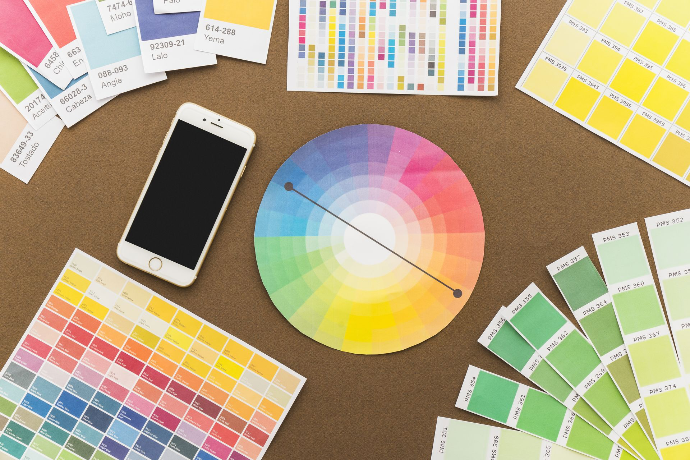
Forecasting Trends and Palette Selection
Before finalizing fabrics, designers align their choices with broader trend forecasts and color palettes. The Indian fashion industry increasingly relies on season-ahead forecasting to guide selections. Local trend agencies and design studios synthesize runway shows, market reports, consumer sentiment and even cultural trends (Bollywood, social media) into forecast boards. For example, industry reports for India explicitly “illustrate… colors, fabric, designs, & silhouettes” along with macro themes and key fabric trends for upcoming. These forecasts often dictate the palette: if a season is predicted to favor jewel tones or earthy brights, the swatch selection will skew to fabrics in those shades. Designers might compile a physical color fan (similar to the one shown below) or digital board to ensure the selected swatches fit the story.
Fig: Designers often consult color swatch fans and mood sketches when planning a collection’s palette. Swatch fans (at right) help match fabrics to seasonal color forecasts. In practice, this means a design team may sort all swatches by hue and discard any that clash with the new palette. For instance, if trend research calls for soft pastels and botanical prints for spring/summer, then designers will gravitate toward cottons and silks in sage, lavender or peach. Conversely, an autumn/winter palette of deep plums and forest greens would steer choices toward heavier fabrics dyed in those rich tones. The forecasting step ensures that by the time fabrics go into development, the collection has a cohesive color and mood story.
Collaborating with Suppliers: Pricing, MOQs, and Customization
With favored swatches identified, brands negotiate with mills or wholesalers to procure yardage. Pricing and order terms are heavily influenced by quantity. Indian suppliers typically quote price breaks at higher volumes; smaller runs incur a premium. As one sourcing guide advises, designers must confirm the minimum order quantity (MOQ) before locking in a deal. Indian mills often require a baseline order (to cover setup costs), so “if your needs are smaller, look for suppliers who offer lower MOQs or be prepared to pay slightly higher prices for smaller batches." Likewise, any customization (a special print, a unique dye or finish) can raise costs: orders “with custom colors, prints or finishes” often come at higher per-unit prices. Creative brands sometimes negotiate mixed-color MOQs or sampling runs to accommodate smaller capsule collections.
Payment terms and lead times are also hashed out. Common terms include partial advance deposits (e.g. 30–50%) or letters of credit for large shipments. The timeline for weaving, printing or dyeing must be clear, since delays can bottleneck production. In many cases, brands and suppliers formalize the deal in a written contract, detailing price, quantity, delivery dates and quality expectations to protect both sides. Good supplier relationships (built on clear communication and timely payment) often yield better pricing and access to new fabrics. In India’s highly networked textile sector, longstanding vendors may even pre-share upcoming fabric ranges or allow first access to limited-edition prints.

Fabric Testing: Shrinkage, Colorfastness and Wash Behavior
Before bulk ordering, most serious manufacturers conduct laboratory tests on any production swatch. This is critical because fabrics can behave unexpectedly after finishing and laundering. Typical tests include shrinkage, twisting (skew), and colorfastness. For a shrinkage test, a marked sample (often 50×50 cm) is washed and dried under standard conditions. Apparel-quality fabrics generally target shrinkage under ~3–7%: for example, cotton knits should ideally shrink no more than about 5–7%, and woven blends around 3–5%. Larger shrinkage means pre-shrinking or resizing patterns is needed.
Colorfastness tests are equally important: labs simulate wash cycles and rubbing to ensure dyes won’t bleed or fade. A common protocol checks how well color holds up under machine washing, light exposure, perspiration, and rubbing. Reputable Indian textile testing labs (e.g., NABL-accredited facilities in Tirupur or Bengaluru) measure color change on a 1–5 scale, aiming for values 4+ on wash/rub tests. These tests help avoid a collection full of garments that run or dull after the first wash. If a swatch fails a key test, the development team may switch to a more stable fiber or insist on a different dye process. In summary, fabric testing on sampled swatches (sometimes at specialty labs in India) ensures that the final yardage will perform as expected in wear and care.
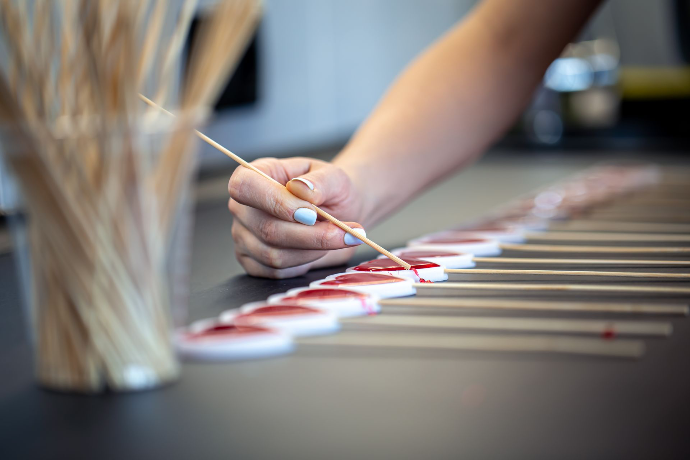
Aligning Fabric with Design and Silhouette
Choosing a fabric is not just about feel – it must also suit the garment’s design. A heavy tweed or brocade swatch would feel out-of-place for a flowing gown, just as gauzy chiffon would flop uselessly on a structured jacket. Experienced designers therefore match swatch properties to the intended silhouettes. As one design guide notes, structured silhouettes require medium-to-heavyweight wovens that hold their shape, whereas fluid, drapey looks demand very soft, lightweight textiles (e.g. chiffon, georgette, rayon). For example, the swatch for a tailored blazer might be a crisp cotton-twill or suiting wool, while an evening dress might use crepe or velvet. Designers will often drape the swatch on a muslin pattern or dress form, checking that seams fall correctly and the fabric molds to the body as envisioned.
Throughout this stage, swatches are indispensable for prototyping. Many fashion educators advise: “Always request swatches before committing to bulk orders. Feeling the fabric and testing its drape can confirm (or change) your initial plan”. In practice, the head designer and pattern maker confer: they may pin the fabric sample into a half-garment to see how much fabric is needed and whether to adjust the cut. If a fabric is too stiff for a design, they might pick a different swatch (or modify the pattern). This iterative alignment ensures that by the time samples are sewn, the fabric’s weight, stretch, and grain all complement the style.
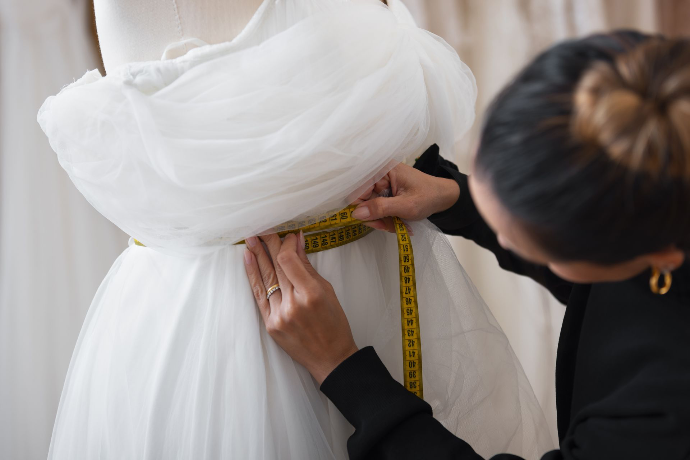
Final Fabric Lineup for Seasonal/Capsule Collections
After sourcing, evaluating and testing, the team curates the final fabric list for the collection. This curation reflects the collection’s theme, season and scale. In a typical biannual cycle (e.g. Spring/Summer vs. Autumn/Winter), the chosen fabrics align with seasonal needs. Industry advice emphasizes this: “Spring and Summer – light fabrics like cotton, linen and chiffon,” versus “Fall and Winter – warm fabrics like wool, velvet and fleece”. Thus, for a summer-ready line, the buyers finalize lightweight plains and floral cotton prints; for winter, they lock in tweeds, suiting wools and heavy silk blends.
For special categories (bridal, eveningwear), the list skews toward luxury textiles: one guide points out that bridal/partywear often calls for “elegant fabrics like silk, satin and lace”. Finally, in a capsule collection (a small, interchangeable wardrobe), the fabric palette is kept tight and versatile. The final swatches might include two or three base fabrics in complementary colors, carefully chosen so each piece can mix-and-match. At every step, the goal is a cohesive collection: the curated fabrics must not only stand out individually but also harmonize together in prints, solids and textures.
In summary, the journey from swatches to a full fabric collection in India is a multi-step process of sourcing, evaluation, trend alignment, supplier negotiation, lab testing, and design fit. By rigorously testing and selecting each fabric sample — whether in bustling Surat textile markets, at a Jaipur crafts fair, or in an urban Mumbai showroom — Indian designers ensure their final line of textiles meets both the creative vision and the practical demands of apparel production.
